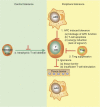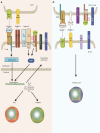Strategies to modulate immune responses: a new frontier for gene therapy
- PMID: 19584819
- PMCID: PMC2835266
- DOI: 10.1038/mt.2009.150
Strategies to modulate immune responses: a new frontier for gene therapy
Abstract
The success of gene therapy strategies to cure disease relies on the control of unwanted immune responses to transgene products, genetically modified cells and/or to the vector. Effective treatment of an established immune response is much harder to achieve than prevention of a response before it has had a chance to develop. However, preventive strategies are not always effective in avoiding immune responses, thus the use of drugs to induce immunosuppression (IS) is required. The growing discovery of novel drugs provides a conceptual shift from using generalized, moderately intensive immunosuppressive regimens towards a refined approach to attain the optimal balance of naive cells, effector cells, memory cells, and regulatory cells, harnessing the natural tolerance mechanisms of the body. We review several strategies based on transient IS coupled with gene therapy for sustained immune tolerance induction to the therapeutic transgene.
Figures


References
-
- Halloran PF. Immunosuppressive drugs for kidney transplantation. N Engl J Med. 2004;351:2715–2729. - PubMed
-
- Kamradt T., and , Mitchison NA. Tolerance and autoimmunity. N Engl J Med. 2001;344:655–664. - PubMed
-
- Thomas CE, Ehrhardt A., and , Kay MA. Progress and problems with the use of viral vectors for gene therapy. Nat Rev Genet. 2003;4:346–358. - PubMed
-
- Bessis N, GarciaCozar FJ., and , Boissier MC. Immune responses to gene therapy vectors: influence on vector function and effector mechanisms. Gene Ther. 2004;11 Suppl 1:S10–S17. - PubMed
Publication types
MeSH terms
Grants and funding
LinkOut - more resources
Full Text Sources
Other Literature Sources
Medical

